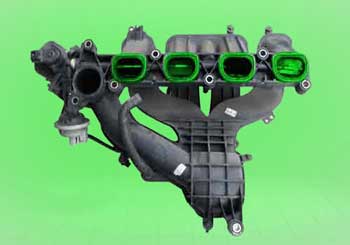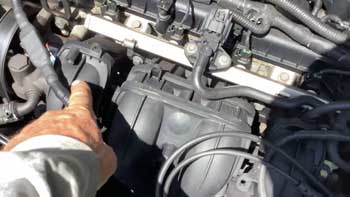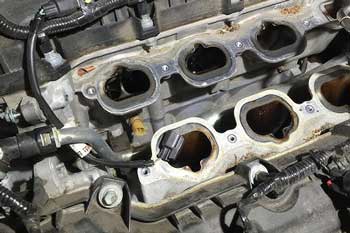P1288 Intake Manifold Short Runner Solenoid Circuit Open Or Shorted
The P1288 Intake Manifold Short Runner Solenoid Circuit Open or Shorted code is a diagnostic trouble code (DTC) that indicates a malfunction in the intake manifold runner control solenoid circuit.
This can be caused by an opening in the wiring, a faulty connector, or a problem with the solenoid valve itself. In some cases, it could also indicate too much resistance in the circuit.
The P1288 Intake Manifold Short Runner Solenoid Circuit Open or Shorted code occurs when there is a break in the electrical circuit that controls intake manifold short runner solenoids (IMSRS).
IMSRS are responsible for controlling airflow into the combustion chamber of your vehicle’s engine at different speeds based on input from sensors such as throttle position, speed, and load conditions.
In this article, we will delve into the details of the P1288 Intake Manifold Short Runner Solenoid Circuit Open or Shorted error code, its causes, symptoms, diagnosis, and effective solutions.
Intake Manifold Runner Control Stuck Open

Intake manifolds are responsible for delivering air from the cylinder head into the combustion chamber at a controlled rate.
In order for this process to work correctly, there needs to be an appropriate amount of airflow through each individual runner that connects from the plenum (a large chamber) directly into each cylinder’s valve head.
The Intake Manifold Runner Control (IMRC) is what helps regulate this flow by opening and closing each individual runner as needed based on engine speed or load demand, allowing more air in if needed or restricting it when not required.
However, if something were to go wrong with one of these runners – like failing or becoming stuck – then you could have serious issues with your engine’s overall performance due to a lack of airflow coming into its cylinders.
Also Read: P1488 Auxiliary 5 Volt Supply Output Too Low
Short Runner Valve
A Short Runner Valve is a type of check valve designed for use in confined spaces with limited access. The design consists of a body containing two ports – one for inflow and one for outflow – connected by an internal chamber that contains two concentric cones or sleeves which act as flow regulators.
When the inflow port opens, water rushes through the sleeve opening and pushes against both sides of the inner cone (or sleeve), generating turbulent flow over its surface area which helps reduce turbulence losses while still allowing adequate water pressure control.
By adjusting the size of these openings, it’s possible to achieve different levels of pressure regulation without having to install larger valves elsewhere in your system.
Read More About: P1199 Radiator Temperature Sensor Voltage Too Low
How Much Does It Cost to Replace an Intake Manifold Runner Control Actuator
The answer depends on the size and makes of your car, as well as where you purchase the part. Generally speaking, the average cost to replace an Intake Manifold Runner Control Actuator is between $200 and $400.
How Intake Manifold Runner Control Works

Intake Manifold Runner Control (IMRC) is a system used by modern engines to improve fuel economy and performance.
IMRC allows the engine to control the intake manifold runner length, which changes how air enters the combustion chamber.
This has a significant impact on engine performance and efficiency, so it’s important for drivers to understand how IMRC works.
The main component of an IMRC system is an electronic valve that opens and closes depending on certain conditions in the engine.
The valve is attached directly to the intake manifold runners, which carry air from the throttle body into each cylinder of the engine.
When closed, this valve restricts airflow into each cylinder and increases backpressure in the intake manifold runners, resulting in higher torque at lower RPMs.
On some vehicles with variable cam timing (VCT), this can further increase power at low speeds while improving fuel economy when cruising at higher speeds due to reduced pumping losses associated with increased back pressure.
Read More About: P1492 Battery Temperature Sensor Voltage Too High
Intake Manifold Actuator
In modern engines, the intake manifold actuation system is an important component in controlling engine performance.
It plays a vital role in delivering the right quantity of fuel and air to the cylinders, which helps provide optimal power output.
The intake manifold actuator works by modulating the air entering each cylinder and controlling exhaust gas recirculation (EGR) flow.
This helps ensure that the correct amount of fuel for combustion is delivered at all times, resulting in improved efficiency and reduced emissions from your vehicle.
The intake manifold actuation system consists of several components including an actuator motor, throttle body assembly, EGR valve assembly, and a vacuum hose.
The actuator motor is responsible for opening or closing valves to control airflow through the intake manifold based on signals from sensors located throughout the engine bay.
The throttle body then regulates how much air enters each cylinder while also providing information about atmospheric pressure for engine management systems to use when determining proper ignition timing and fueling requirements.
At regular intervals during operation, fuel delivery must be adjusted according to these parameters to ensure optimal performance as well as reduce emissions levels such as carbon monoxide (CO).
Subaru Intake Manifold Runner Control

In simple terms, the IMRC is a mechanical device that controls airflow into your engine cylinders from the intake manifold. The purpose of this system is to provide optimal levels of airflow at varying rpms while keeping emissions low.
It works by using two flaps or valves that open and close depending on the speed of the engine – when more power is needed, they open up more allowing more air in; when less power is required they close off reducing incoming airflow.
The IMRC also plays an essential role in helping keep emissions under control as well as improving fuel efficiency since it can reduce unneeded air entering cylinders which wastes energy due to back pressure buildup inside them – something known as ‘overrun’.
Also Check: P1495 Leak Detection Pump Solenoid Circuit Open Or Shorted
Common Causes of P1288 Error Code
Several factors can lead to the occurrence of the P1288 error code. Here are the potential list.
1. Faulty Short Runner Solenoid
Over time, the short runner solenoid can experience wear and tear, leading to internal malfunctions. These malfunctions can cause the solenoid to become unresponsive or operate outside the expected parameters, triggering the error code.
2. Wiring Issues
Corrosion, damage, or disconnection of the wiring connected to the short runner solenoid can disrupt the circuit’s continuity. This interruption in the circuit can lead to the error code being triggered.
3. Electrical Problems
Issues with the electrical connections of the solenoid, such as poor contact or damaged connectors, can result in inconsistent signals being sent to the solenoid. This can lead to erratic behavior and trigger the error code.
4. PCM (Powertrain Control Module) Problems
The PCM, which controls various aspects of the engine’s performance, can malfunction and send incorrect signals to the solenoid. This can disrupt the solenoid’s operation and lead to the error code being generated.
Symptoms of P1288 Error Code
When the P1288 error code is triggered, it is often accompanied by noticeable symptoms:
i. Illuminated Check Engine Light
The most common symptom is the illumination of the Check Engine Light (CEL) on the vehicle’s dashboard. The CEL serves as an early warning system, indicating that the vehicle’s computer has detected a potential issue.
ii. Changes in Engine Performance
The engine’s performance may be adversely affected. This can include rough idling, reduced power during acceleration, and an overall decrease in fuel efficiency. These symptoms can vary in intensity based on the severity of the circuit issue.
iii. Other Potential Warning Signs
In some cases, drivers may notice unusual engine noises, vibrations, or even engine misfires. These symptoms can arise due to the disrupted air intake and combustion processes caused by the malfunctioning short runner solenoid.
Also Read: P1496 5 Volt Supply Output Too Low
Diagnosing P1288 Error Code

Diagnosing the P1288 error code involves a systematic approach to identifying the root cause of the issue:
1. Using an OBD-II Scanner
An OBD-II scanner is used to retrieve the error code from the vehicle’s computer. This code provides valuable information about the nature of the problem, allowing technicians to narrow down their diagnostic efforts.
2. Testing the Solenoid
Using a multimeter, technicians can measure the resistance of the short runner solenoid. Deviations from the expected resistance range can indicate internal solenoid problems.
3. Inspecting Wiring and Connections
Technicians carefully examine the wiring and connections related to the short runner solenoid. They look for damaged wires, loose connections, and signs of wear that could disrupt the circuit’s continuity.
Steps to Fix P1288 Error Code
Based on the diagnostic findings, appropriate steps can be taken to address the P1288 error code:
i. Repairing or Replacing the Short Runner Solenoid
If the solenoid is found to be faulty, it can be repaired or replaced, depending on the extent of the damage. Replacing the solenoid with a new, high-quality component is often recommended to ensure long-term reliability.
ii. Addressing Wiring and Connection Problems
Any damaged wires or connectors should be repaired or replaced. Ensuring secure and clean connections is crucial for maintaining proper circuit functionality.
iii. Dealing with PCM Issues
If the PCM is identified as the source of the problem, it may need to be reprogrammed or replaced. PCM replacement should be done by a professional to ensure proper configuration and compatibility with the vehicle.
Frequently Asked Question
1. What Is Code P1288 Mean?
The P1288 error code indicates a problem with the “Intake Manifold Short Runner Solenoid Circuit Open or Shorted.
This means there’s an issue with the electrical circuit that controls the solenoid responsible for adjusting the length of the intake manifold runners in your vehicle’s engine.
2. What Causes The P1288 Error Code To Appear?
Common causes include a faulty short runner solenoid, damaged or disconnected wiring, electrical problems, and issues with the Powertrain Control Module (PCM), which controls the engine’s performance.
3. What Symptoms Might I Experience If My Vehicle Has The P1288 Error Code?
You might notice the Check Engine Light (CEL) turning on, rough idling, reduced power during acceleration, decreased fuel efficiency, strange engine noises, vibrations, or even engine misfires.
4. Can I Continue Driving With The P1288 Error Code?
It’s best to address the issue as soon as possible. While you might still be able to drive, ignoring the problem could lead to decreased engine performance and fuel efficiency over time.
5. Can I Fix The P1288 Error Code Myself?
If you have some automotive knowledge, you can diagnose and so;ve the error code.
2005 Ford Focus No Start
Conclusion
The P1288 Intake Manifold Short Runner Solenoid Circuit Open or Shorted error code serves as a reminder of the intricate systems at play within modern vehicles.
The intake manifold short runner solenoid’s role in optimizing engine performance is crucial, and any disruptions to its operation can have a significant impact on the vehicle’s efficiency and power delivery.
By understanding the causes, symptoms, and diagnostic procedures associated with the P1288 error code, vehicle owners can take proactive steps to ensure their vehicles operate at their best.